Military Education and Training
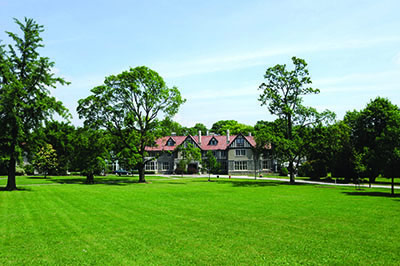
DND photo TC2012-0046-15 by Sergeant Charles Barber, J6 Imagery, CFCl
Officers Mess, Canadian Forces College.
Educating the New National Security Professional: A Review of the National Security Programme at the Canadian Forces College
by Brent Griffin
Colonel Brent Griffin is a member of the United States Air Force, and he currently serves in the International Security Affairs division of the Office of the Secretary of Defense at the Pentagon. He served four years as an exchange officer at the Canadian Forces College, three as the National Security Programme Curriculum Lead and the Deputy Chair of the Department of Security and International Affairs.
For more information on accessing this file, please visit our help page.
Introduction
With the demise of the Soviet Union more than twenty years ago, the relatively clear lines dividing the superpowers began to fade, and as one pole of the post-war, bipolar world dissolved, national and cultural feelings previously contained by the force of Cold War political reality began to resurface. Exacerbated by increasing globalization, this rise flared into violence and increasing instability across the globe, as post-Cold War flashpoints began to seemingly or actually threaten national interests in established states. The Cold War world, defined by the standoff between two armed contenders, devolved into a ‘new normal’ with a host of new concerns characterized by a variety of new terms – the ‘Axis of Evil’ and the ‘Arc of Instability’ to name but two.1 This new environment shared none of the seemingly comprehensible qualities of the preceding half-century; on the contrary, it proved increasingly subject to ostensibly intractable problems that, on the surface, made nuclear chess look downright reasonable. At the very least, the protagonists during the Cold War shared a relatively common and understandable interest in survival, even if their ideologies did not match. Given this changed reality, how does today’s state deal with religious zealotry, racial antagonism, ‘warlordism’ and other movements which cascade through Westphalian state boundaries and threaten neighbouring political entities or even those half a world away? And in a similar vein, what impact can less dramatic phenomena like globalization, resource scarcity, and migration have on state security?
The answers to these questions and others like them are not readily apparent, and in some cases, they are conspicuously absent. In many cases, today’s wisest minds have not even determined the proper questions to ask. In the two decades since the implosion of the Soviet Union, governments have begun to grasp both the enormity of the problems they face, and their interconnectedness. The organizational effort to cope with the real national and transnational issues of the day has begun, but the educational process is anything but complete. While ‘Whole of Government’ is a phrase understood by many both within the Canadian Forces (CF) and the broader Government of Canada (GOC), in so many ways, it is only a nebulous concept that suggests some level of coordination with other government departments and agencies, most often in the context of national defence or overseas peace building efforts. This is, perhaps, too limited a focus, based upon an arguably false analogy that equates national security with national defence. Perhaps whole-of-government policy and strategy should extend beyond the narrow confines of defence to the broader playing field of national security. The immersion of senior CF officers, GOC executives, and select members of the private sector in issues like those above is the focus of the National Security Programme (NSP), a ten-month course of study designed to help its participants grapple with the problems of the new normal, and to develop comprehensive methods for dealing with them.
The Environment
Not surprisingly, the 2008 Canada First Defence Strategy has characterized the new normal as volatile and unpredictable, stating: “Today we live in an uncertain world, and the security challenges facing Canada are real.”2 But while the Strategy alludes to a broader definition of security than the ‘military-centric’ version generally espoused by those in uniform, it does not explicitly define the term. For that, one must look four years earlier to Securing an Open Society: Canada’s National Security Policy, a document which describes itself as “… the first-ever policy of its kind in Canada.”3 In its opening chapter, Securing an Open Society defines the scope of national security as follows:
National security deals with threats that have the potential to undermine the security of the state or society. These threats generally require a national response, as they are beyond the capacity of individuals, communities or provinces to address alone.4
This is not an entirely different sentiment than that attributed to one of America’s greatest diplomats, George Kennan. In a draft paper entitled Comments on the General Trend of US Foreign Policy, Kennan defined national security as, “… the continued ability of [a] country to pursue the development of its internal life without serious interference, or threat of interference, from foreign powers.”5 These definitions are both deliberately and necessarily vague, in large part because the environment that they define is both ambiguous and complex, and the threats that they envision cannot be relegated to any given sphere – diplomatic, informational, military, economic, or cultural. In short, they describe an idea that is anything but clean, and suggest that the nature of policy to support it should be anything but linear or restricted to a single solution.
If one accepts the above definitions as realistic (if not concrete), one would likely also accept, as just inferred, that courses of action in addressing national security issues can include a variety of approaches – or perhaps even more accurately stated, a comprehensive approach involving multiple forms of national power. Although victory in the Cold War can hardly be attributed only to military might, the militaries of the West have had considerable difficulty in ‘jettisoning’ the Cold War paradigm of the garrison force and a purely military response, to issues related to national security. This certainly is not meant to imply that progress has not been made in this regard; on the contrary, the past decade has seen remarkable improvements in intra- and inter-governmental cooperation in domestic and international operations. But this cooperation has been two decades in the making, and it has largely been a result of trial and error. Teamwork has often been a result of ‘hard knocks’ delivered through years of hard work in Afghanistan, Iraq, and other hot spots around the globe. Many barriers have been broken, yet these barriers have been largely at the tactical and operational levels. To date, there has been very little in the way of a formal framework developed to link national policy with national strategy in a comprehensive, whole-of-government manner. On the inter-governmental front, while international organizations and laws exist to facilitate cooperation, many of today’s issues range from contentious to insoluble – despite the best of intentions and efforts to build ‘coalitions of the willing.’
| DP1 | DP2 | DP3 | DP4 | DP5 |
|---|---|---|---|---|
| NCdt/OCdt A/SLt/2Lt |
Lt(N)/Capt SLt/Lt |
Cdr/LCol LCdr/Maj |
Capt(N)/Col | Flag/General Officers |
|
|
|
|
|
The Gap
Where does this leave the Canadian Forces senior officer and the CF’s developmental education continuum? The latter is perhaps the easier to answer, at least in the pre-developmental period (DP) four arenas. Represented at the Canadian Forces College (CFC) by the Joint Command and Staff Programme (JCSP), DP-3 focuses upon the operational level of war. The stated aim of the JCSP is “… to prepare selected senior officers of the Defence Team for command and/or staff appointments in a contemporary operating environment across the continuum of operations in national and international settings.”6 As its aim implies, JCSP is the bridge between the tactical and the strategic. While it bleeds into both, it does so only to understand tactical limitations and strategic realities at the operational level. Given the DP-3 focus upon the operational level of war, it stands to reason that DP-4 should look beyond the operational towards the strategic. How has it met this expectation over time?
Prior to 2008, the CF relied upon two courses at CFC to meet the mandate of DP-4 education: the Advanced Military Studies Programme (AMSP), and the National Security Studies Programme (NSSP).7 Situated firmly in the nexus between the operational and strategic levels of war, the aim of the AMSP was “… to prepare selected Colonels/Captains(N) for operational level command and for senior staff appointments within operational level joint and combined headquarters.”8 Its counterpart, the NSSP, sought “… to prepare general/flag officers, selected colonels/naval captains and civilian equivalents, for strategic responsibilities in the development, direction and management of national security and defence policy.”9 In tandem, these two programmes carried professional military education delivered in earlier development periods to a broader, if somewhat military-centric, level of understanding regarding the strategic arena. Running sequentially over 15- and 25-week periods respectively, the AMSP and NSSP were mutually reinforcing programmes which together delivered DP-4 credit to a Canadian senior officer. More often than not, delivery was staggered over a multi-year period, allowing the officer to dedicate smaller chunks of time to education. The benefit of this dual-programme approach to learning was its flexibility. Its disadvantage was its military-centric nature – the foci of the strategic-level NSSP being strategic command and institutional leadership; defence resource management; Canadian national security and international relations; and power, military strategy, and readiness.
Student profiles on AMSP and NSSP reflected the martial nature of the two programmes. Reflecting its aim, AMSP counted only military officers amongst its participants, a portion of them internationals. NSSP, on the other hand, did incorporate ‘civilian equivalents’ into its ranks, although not in very significant numbers.10 Moreover, each of these civilians came from the Department of National Defence (DND) – and nearly all from Defence Research and Development Canada. So, although these participants offered viewpoints substantively different from those in uniform, the parochial defence paradigm remained intact. In fact, although the aim of the NSSP was to prepare participants to manage “national security and defence policy,” it arguably only did so directly in the military sphere. DP-4 through 2008, then, built effective defence professionals, but, given the broader definition of national security described in the preceding section, the claims of AMSP and NSSP to effective development of national security professionals was dubious, especially in the whole-of-government context. In the decades following the Cold War, and especially in the span of time following 9/11, expertise focused upon military solutions to national security issues was not enough.
The Fix
Despite their shortcomings, AMSP and NSSP did a commendable job in meeting the ongoing efforts by the CF to educate officers in “national policy and security problems; scientific, political, economic and military factors influencing Canada and other states; and Canada’s place on the international scene.”11 More importantly, they served as springboards for development of an even more aggressive programme in this domain – the National Security Programme (NSP). Cognizant of some of the limitations inherent in the CF’s contemporary approach to senior officer education, the Armed Forces Council (AFC) directed sweeping changes to DP-4 in 2008 through a programme designed to “… prepare all participants for employment as strategic-level leaders and managers, and military officers as operational-level joint task force commanders and senior staff.”12 Explicit in the AFC direction were two key points which clearly differentiated the NSP from its predecessors: its method of study, and its nominal roll.

Brad Lowe, Base Photo, CFB Kingston
Moon over the Mackenzie Building, Royal Military College of Canada.
The first was a rather important departure from previous practice in that the AFC mandate directed that NSP be conducted “along post-graduate study lines” with an optional Royal Military College of Canada (RMCC) Master of Arts degree as part of the package.13 This mandate necessarily changed the flavour of the NSP when viewed against its antecedents. First, while AMSP and NSSP were certainly robust from a curriculum perspective, they had significantly less emphasis – as measured by writing opportunities – on individual critical thought. Where written work in these programmes represented only 30 percent (about 200 hours) of total contact time with instructors, that in NSP exclusive of the Masters represents about 80 percent (approximately 470 hours). In a similar vein, instruction on the NSP is vastly different in methodology. AMSP and NSSP were delivered in the ‘traditional’ manner of most Professional Military Education (PME) facilities; participants were exposed to a variety of guest speakers and instructors with classroom continuity provided by a Senior Directing Staff (SDS) – normally a contracted retired general or flag officer. NSP methodology shattered this paradigmatic approach to PME, relying instead upon a blend of doctorate-level teaching teams, which provide academic continuity through each of seven integrated core courses and SDS (refashioned as Senior Mentors in the programme’s second serial), who have been entrusted with relating these intellectually rigorous studies to professional practice. And while emphasis upon external speakers has been diminished as a result of the new teaching concept, guests still play a valuable role in providing outside viewpoints to NSP participants at selected points in the curriculum. In short, the new tripartite methodology purposefully strings together the various instructional themes of the programme into a more continuous whole – one that holistically links theory and practice in admirable fashion.
The second key factor in this evolutionary process was an explicit adjustment to the structure of the NSP nominal roll. This structure was evident in the AFC guidance, which read: “International military officers, DND executives and civilians from other government departments and agencies may also participate in the NSP” (emphasis added).14 As previously discussed, civilian participation on AMSP was non-existent, and such involvement on NSSP was limited to no more than one-tenth of the roll, and composed only of DND executives. NSP has broken new ground in this respect. In the pilot serial, civilian executive membership ballooned to 25 percent, and included participants from the Department of Foreign Affairs and International Trade, Public Safety Canada, the Department of Justice, and Public Works and Government Services Canada, in addition to one member from the private sector, and three members from DND. The aggressive campaign for a comprehensive nominal roll continued into follow-on serials. As the programme hit steady state in its third iteration, it boasted a civilian contingent of one-third drawn from eight different government departments/agencies and the private sector. This wide-ranging student base has important, beneficial impact upon all participants – military to civilian, Canadian to international; it is perhaps the value of this dynamic that accounts for the 42 percent hike in civilian participation, and the corresponding jump of 33 percent in outside organizations represented between the first and third serials.
In short, the NSP represents a ground-breaking, holistic approach to the problems of today, and where AMSP and NSSP were appropriate in their time, NSP is appropriate now. Through careful balancing of teaching method and programme composition, the NSP seeks to bridge the gaps among governmental agencies, and between the public and private sectors. And it does so through a well-considered blend of critical thinking, fostered by academic study and professional growth cultivated by retired practitioners. This leads to the most important question of all; namely, what does the NSP graduate provide to both the Canadian Forces and the Government of Canada?
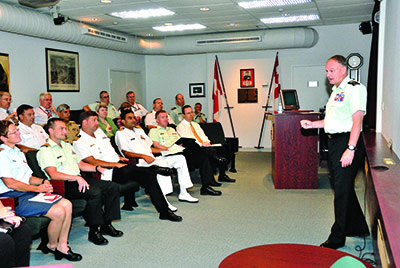
DND photo by Sergeant Charles Barber, J6 Imagery, CFC
Course NSP 01 ‘gets an earful’ from a very experienced soldier, Brigadier-General David Fraser.
The Result
The NSP graduate is a unique individual capable of fulfilling four important roles within the broader national security apparatus of the state. Participants leave the programme with the requisite understanding to serve as a Leader of the Institution, to act as an Implementer of National Security Policy, to perform as a Designer of National Strategy, and to operate as an Interpreter in the Nexus (between the strategic and operational).15 These capacities are not confined to the sphere of defence, or to the nation of Canada; leaders graduating from the NSP bring their newfound expertise to the civilian public and private sectors, and to the foreign nations from whence they came. The skill set delivered by the NSP is perhaps one of the most universal designed to date. And while this skill set is distinctly Canadian in flavour, the programme is designed to provide full equivalency with a number of war colleges run by Canada’s allies, such as those in Australia, Brazil, Pakistan, Poland, the United Kingdom, and the United States.16
Before discussing these unique competencies at any length, it is important to understand the migration of NSP from a blend of AMSP and NSSP into its own unique programme with its own distinct aim. As mentioned earlier, the aim of the pilot serial unified those of NSP’s forebears into a coherent whole, doing so in a manner that maintained two foci – a duality that was, at times, difficult to rectify. Having identified the difficulties in addressing both the strategic and operational levels in a single curriculum during the first two serials, the aim of NSP veered distinctly towards the strategic in the third and fourth serials. The current aim reads as follows:
The aim of the NSP is to prepare selected military, public service, international and private sector leaders for future strategic responsibilities within a complex and ambiguous global security environment.17
This new aim, clearly different than its predecessor, unequivocally ‘placed NSP on its own road.’ First, it defined the nominal roll, and, by dint of naming its players, forced NSP into the national security arena, rather than the more narrow defence realm. Second, the new aim drove NSP unmistakably onto the strategic plane, challenging participants to think in terms of linking national ways and means to ends, rather than thinking in more conventional campaign terms. Finally, it defined the environment, challenging students to think in ‘shades of gray,’ rather than in ‘black and white.’
In an effort to familiarize participants with environmental ambiguity, the NSP curriculum imbeds complexity into both its courses and practicum. Academically, NSP pursues five programme goals to meet this end:
Strategic Command and Institutional Leadership. To further develop the participants’ ability to evaluate and apply the principles of strategic command, leadership and management in leading the institutions of defence and national security and to evaluate and characterize institutional culture and ethos.
Strategic Resource Management. To refine the participants’ understanding of strategic resource management in order to analyse institutional human resource policy and to evaluate the impact of the Defence Resource Management System in generating and sustaining a national capacity to meet Canada’s security needs.
Canadian National Security and International Relations. To further develop the participants’ understanding of factors, both internal and external to Canada, that influence the implementation of Canada’s national security policy and to examine the (international) geostrategic environment that influences national security strategy as it pertains to Canada’s national interests and the promotion of Canada’s values.
Strategic Concepts: Strategy Formulation and the Application of National Power. To further develop the participants’ understanding of the elements of national power through an examination of its diplomatic/political, informational, sociocultural, military, and economic determinants; to analyse their influence on Canada’s strategic options; and to evaluate the controls on their implementation in intra-, inter-, and non-governmental environments.
Comprehensive Campaign Planning in Complex Environments. To develop the participants’ capacity to design comprehensive national and multinational campaign plans to generate strategic effects in complex security environments.18
The concepts enshrined in these goals seem relatively straightforward when taken at face value, but the simplicity ends there. Participants in the programme are asked to examine them from a different perspective, both academically and professionally. In each case, the individual is exposed to varying degrees of complexity, uncertainty, and disorder. Focused upon issues of national and institutional leadership, participants rapidly learn that there are rarely any simple answers to the problems discussed – or perhaps better stated, there are a variety of answers that are more beneficial to some players than to others. Participants learn, not only of the complexity of whole-of-government approaches to complicated issues, but are forced to exercise this learning at various times in the programme in order to get some feel for the consensus approach to decision-making. In cases where the military voice is but one amongst many, persuasion – not direction – becomes the sine qua non of building appropriate, workable solutions.
Understanding the environment is vital to the educational evolution of the NSP graduate, and it helps build an officer who is truly capable of functioning as a Leader of the Institution, rather than simply a Leader in the Institution. The Government of Canada is hardly monolithic, and DND, while owning an important seat at the table, is certainly not the only player. In many cases, it is not even a key player. For these reasons, CF institutional leaders must be able to navigate through a complex, sometimes dangerous political landscape to ensure the health of the department, while simultaneously meeting broader government mandates. In other words, where Leaders in the Institution provide an extraordinarily important function of maintaining the ongoing viability, traditions, and expertise within the organization, Leaders of the Institution are responsible for providing the environment which allows that to happen. Since they are brought to maturity in the environment which they later lead, they are intimately familiar with the makeup and requirements of the institutional organism. The challenge in their new capacity is to represent that organism in the broader governmental context, preserve its integrity against those who would wield it in a manner inconsistent with its anatomy, and direct it in areas outside of its comfort zone when required by the state. Leaders of the Institution, while children of the institution, are vital to both its continued well-being and its utility in the broader governmental context.
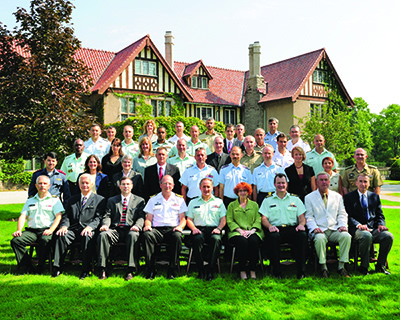
DND photo by Sergeant Charles Barber, J6 Imagery, CFC
NSP 03 course photo.
NSP graduates are also Implementers of National Security Policy, a job that dovetails with their position as Leaders of the Institution. Because they have studied policy and strategy at the national level, they can flow into new positions with a more wide-ranging understanding of the architectural framework behind policy and strategy design, the key players in the bureaucratic environment, and the schema which drive outlooks within other organizations (both public and private, state and non-state). Attained through the comprehensive, professionally-based academic slate of the NSP, this knowledge is paired with lab-like experience earned through realistic field study and exercise activities embedded throughout the programme. While not a perfect substitute for related on-the-job experiences, the NSP practicums unquestionably expose future leaders to the nature and complexity of issues they will face upon graduation. Academically and experientially versed in a controlled environment, each participant graduates with the capacity to flow almost seamlessly into a position where he or she can play an immediate and consequential role guiding the institution in the implementation of national security policy.
Akin to this role is that of Designer of National Strategy. As national strategy should flow directly from the policy from which it was derived, it is natural that, as a Leader of the Institution and an Implementer of National Policy, the NSP graduate plays a critical role in translating policy into strategy. Strategy, the tool that links political ends to ways and means, is vital in making policy practical; in other words, a policy without a strategy is merely an idea. Ensuring that the idea can be practically supported from the twin standpoints of capability and capacity is the key to its successful implementation. Programme participants, already leaders in their respective institutions, tend to understand intuitively whether their own institution has the capability and capacity to fulfill a given policy. What they gain from the NSP is an understanding of how to synergize these with other state and global actors, an insight into how to cooperate with other players to achieve broader goals, and an appreciation for the alignment of policy with national purpose and interest which may not be readily recognizable from within their home institution. The triangular nature of the first three roles is mutually reinforcing, and, in the long run, if not always the short, is vital to the health of both the state and the institution which the individual participant serves.
The previously-described roles tend to exist in unity at the upper levels of the bureaucratic hierarchy. They interact for the good of both the state and the institution, but of what use are they if unable to drive the much larger pyramidal base? Obviously, they have negligible impact if not supported by the fourth role which the NSP impresses upon its participants – that of Interpreter in the Nexus. As enshrined in the first programme goal, communication through enlightened leadership and command is vital to the implementation of policy through both the design of realistic strategy and the ability to interpret strategic vision for the institution in which the NSP graduate serves. In short, it is not enough to provide strategic direction, for direction misinterpreted is direction misapplied, and is likely at odds with that of other actors. At best, poorly interpreted direction results in loss of the synergy gained through proper strategic design; at worst, it can have catastrophic repercussions upon the international playing field. Opportunities to understand the importance of communication are embedded in both academic and practical activities throughout the programme. Through the study of communication and command models, participants gain an appreciation for the theoretical aspects of leadership and management at higher levels. Exercises and field studies reinforce this theory, and give the participants opportunity to utilize it in a relatively sterile environment, testing their communication skills in or in front of simulated parliamentary committees, media teams, coalition headquarters, and inter-departmental crisis teams. While perhaps not necessarily at ease with being the Interpreter in the Nexus by the end of the programme, participants can rightly say that they have been rigorously exposed to this function, and have had the opportunity to reflect upon its importance.
These four mutually-enforcing roles provide the CF with a well-rounded, versatile officer who, while not necessarily an authority in the complex, ambiguous environment of which he or she is about to become part, is both aware of its intricacies, and capable of considered action. More importantly, the graduate has the understanding and wherewithal to grasp the ‘big picture,’ translate it into a workable strategy, and drive his or her institution in a direction consistent with both national policy and institutional well-being. In a world that has become increasingly global, and where the far-reaching impact of seemingly innocuous decisions can reverberate elsewhere with deafening concussion, such capabilities in a senior officer corps are neither to be underrated, nor taken for granted. The welfare of Canada, the Department of National Defence, and the Canadian Forces is dependent upon it.
Conclusion
The intent of this short article was to highlight both the need for a course like the NSP, and to explain the criticality of the officer which the programme returns to the system. By the end of its third run, NSP had graduated 53 participants from its rolls, 28 of whom have been CF officers who returned to the field to serve as critical players in the operational and strategic architecture of the Canadian Forces. Ten have earned a Master of Arts in Security and Defence Management and Policy from RMCC, and by the end of the 2011 academic year, four had achieved flag rank, giving these select few an even broader audience to serve, and a more appreciable arena in which to effect worthwhile change in the interests of national and institutional good. In all, the NSP has provided considerable ‘bang for the buck,’ and it offers the CF a versatile officer who is literate in both the needs of the institution and the needs of Canada itself.
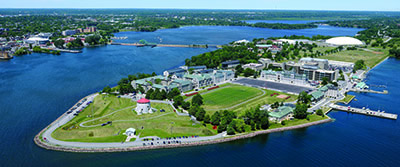
S. McQuaid, Base Photo, CFB Kingston
Aeriel view of the Royal Military College in Kingston, Ontario.
The NSP is a unique programme within Canada that serves as a laboratory for senior officer excellence. It offers a course of study that few other institutions can match, in an environment that fosters whole-of-government understanding, appreciation, and evolution. While comprehensive interaction is certainly not uncommon in today’s areas of conflict, mutual understanding between actors is often superficial and sometimes inflammatory. NSP provides an opportunity to understand various viewpoints, work through mutually amenable solutions, and communicate in a language common to the actors. It provides a deep-seated ability to think critically, and to analyze situations at more than just a cursory level. These benefits serve, not just the graduate, but those to whom he or she is responsible, those who are responsible to him or her, and those who are equals on the playing field. This sort of capacity can be contagious at the national, local, and institutional levels.
In his biography of Victorian general Charles George ‘Chinese’ Gordon, Sir William Francis Butler wrote: “The nation that will insist upon drawing a broad line of demarcation between the fighting man and the thinking man is liable to find its fighting done by fools and its thinking done by cowards.”19 According to Butler, Gordon was a man who realized that soldiering meant more than fighting, and that thinking meant more than simply excelling in military tactics. In other words, he understood that there was no checklist for dealing with the complexities of the world, and he appreciated that armed conflict was perhaps neither the best nor the only solution to the pressing issues facing Britain’s empire in the late-1800s. In the main, today’s problems are little different than those faced by Gordon, Butler, and their contemporaries. The confluence of past and present suggests that today’s world needs more Gordons – men and women who can think critically and appreciate problems from different perspectives. The NSP seeks to do just this by taking promising officers and strengthening these qualities within them. In so doing, this vital Canadian programme offers an educational environment of which both Gordon and Butler would likely be proud.
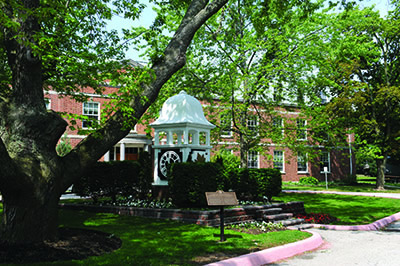
DND photo by Sergeant Charles Barber, CFC
Administration Building, Canadian Forces College.
NOTES
-
The ‘Axis of Evil’ was first mentioned by President George W. Bush in his 2002 State of the Union address. See George W. Bush, “The President’s State of the Union Address,” 29 January 2002; http://georgewbush-whitehouse.archives.gov/news/releases/2002/01/print/20020129-11.html, accessed 4 June 2012. The background of the term ‘Arc of Instability’ is somewhat more nebulous, with references to the term found as far back as the 1970s. Australia began using the term in the late-1990s in reference to areas of the Pacific, and it increasingly entered the US military planning lexicon in a broader geographical context following the 11 September 2001 attacks.
-
Department of National Defence, Canada First Defence Strategy (Ottawa: DND Canada, 2008), p. 6.
-
Privy Council Office, Securing an Open Society: Canada’s National Security Policy (Ottawa: PCO Canada, 2004), p. vii.
-
George F. Kennan, “Comments on the General Trend of U.S. Foreign Policy,” in George F. Kennan Papers (Box 23), (draft paper, Princeton University, 20 August 1948), quoted in John Lewis Gaddis, Strategies of Containment: A Critical Appraisal of American National Security Policy During the Cold War, 2ndEd. (New York: Oxford University Press, 2005), p. 26.
-
Canadian Forces College, Joint Command and Staff Programme Syllabus: JCSP Residential and JCSP Distance Learning (Toronto: Canadian Forces College, 2011), 1-1/9.
-
Earlier versions of these programs were the Advanced Military Studies Course and the National Security Studies Course. The change in title reflected a change in CFC nomenclature and did not significantly affect course curriculum, though the focus drifted more towards the strategic in the former. For ease, AMSP and NSSP will be used in this document for standardization.
-
Canadian Forces College, Advanced Military Studies Programme 10 Syllabus (Toronto: Canadian Forces College, 2007), para 201.
-
Canadian Forces College, National Security Studies Programme 10 Syllabus (Toronto: Canadian Forces College, 2007), para 201.
-
A review of CFC’s nominal rolls showed that only 16 of 167 total students were not in the military; this equates to just under ten percent of the student population.
-
Canadian Forces College, National Security Programme 1 Syllabus (Toronto: Canadian Forces College, 2008), 1-1/2.
-
Chief of Military Personnel, CANFORGEN 064/08 New National Security Programme (NSP) (Ottawa: DND Canada, 3 Apr 2008), para 3.
-
Department of National Defence, B-GJ-005-500/FP-000 Canadian Forces Joint Publication 5.0 (CFJP 5.0): The Canadian Forces Operational Planning Process (OPP), Change 2 (Ottawa: DND Canada, April 2008), paras 106.1-2. Strategic and operational refer in this case to two levels of war commonly discussed in PME. Contemporary CF doctrine defines strategy as “the concept that links available national resources to government ends – over time and as circumstances change. For the Department [of National Defence] and the Forces, strategy is about how to use our resources to best support the government’s aims” (106.1). The operational level, on the other hand, focuses on the “joint employment of land, maritime and aerospace forces employed in sequential and simultaneous engagements that are linked by design in a campaign plan” in an effort to meet strategic ends (106.2).
-
For a list of fully equivalent schools, see Canadian Defence Academy, Canadian Defence Academy (CDA) Directive 02/12 Officer Developmental Period 4 (ODP4) Equivalency (Kingston: Canadian Defence Academy, 23 April 2012), A-1/1. Partial equivalency from a variety of programmes is also available as laid out in the subject document.
-
Canadian Forces College, National Security Programme 4 Syllabus (Toronto: Canadian Forces College, 2011), 1-1/9. The aims for NSP 3 and 4 are identical.
-
Colonel Sir William Francis Butler, Charles George Gordon (London: MacMillan and Co., 1889), p. 85. This quote (or one like it) is often attributed to Thucydides, but this author could find no mention of it in any of the current or historical editions of the famous Greek’s History of the Peloponnesian War – his only known piece. The quote in this article can be attributed to Colonel Sir William Francis Butler, who wrote an important biography of Major-General Charles George Gordon, the British officer who famously met his end at Khartoum. In the passage preceding the above quote, Butler wrote:
Gordon understood the fact that nations as well as individuals have pulses, that the leader who would lead to any definite end must know how to count these pulsations, and, in addition to his skill as a sword-cutter, must be able to do a good deal of the binding up of wounds, even though he had himself caused them. To say this is, of course, only to say that Gordon was great, in a sense greater than any merit of action in arms could aspire to.
Gordon seemed to have understood that while war involves breaking, it also involves building. Likely, he would have been a keen advocate of the National Security Programme.







